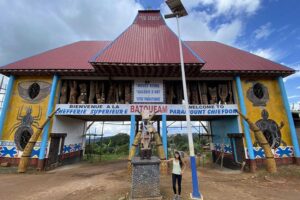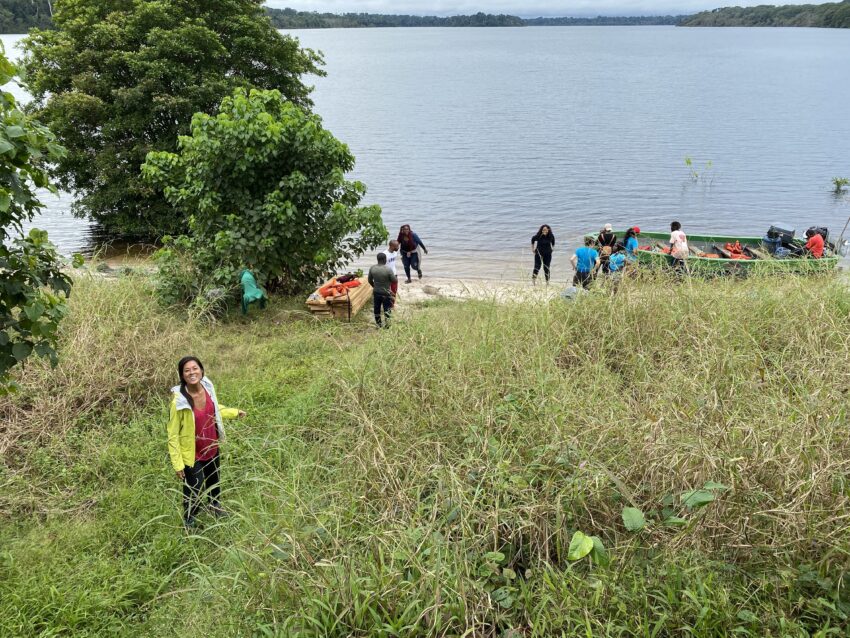
A Boat Trip up River in Cameroon to Douala-Edéa National Park
By Annie Chen
GoNOMAD Senior Writer
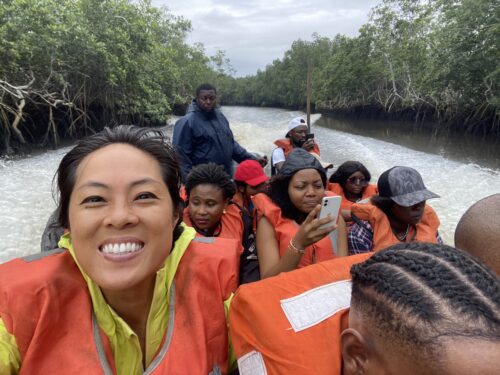
Cameroon is touted as one of the most biodiverse countries in Africa, if not the world.
It’s often called “Africa in miniature” for its wide-ranging span of not only cultural and linguistic variety but also a far-reaching population of freshwater, forest, and sea flora and fauna.
Out of the 10 regions of the country, each boasting its own unique ethnic makeup and folklore, the Littoral region has one of the widest ranges, given its unique geographic positioning and proximity to the forest, savannah, and beaches.
When the opportunity rose to visit the Douala-Edéa National Park, I immediately signed up without knowing a lot of details. It turns out that the 2,629 km2 space was formerly a wildlife reserve established in 1932.
Although it had a conservator and guard post by 1974, the reserve couldn’t be made into a full-blown national park due to valuable oil reserves found on the coastline.
Full Protection of the Cameroon Forest
Finally, by 2018, it was officially recognized as a national park, with full protection of its tropical lowland forests inland and coastal mangrove forests. A number of endangered and threatened species reside within the space with rampant overfishing and illegal poaching.
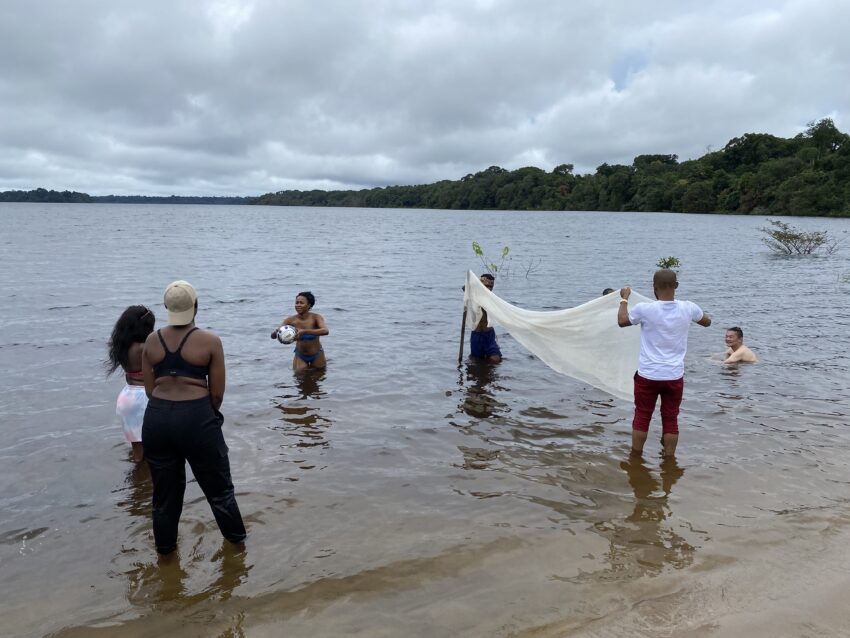
Arriving on a moto-taxi, I hopped off to land in the soft mud of Youpwe, the fishing port neighborhood of Douala. 17 others drifted in moments later, taking in the sight of the large industrial fishing boats off in the distance mixed with the wooden boats tied to the shore. A large truck was parked in reverse down the slope to receive the bags of shells fishermen were heaving into the truck, and our feet crunched on a mix of stones and broken shells from past hauls.
My friend mentioned that the clams and oyster shells were shattered and incorporated into chicken feed, as chickens were the cheapest meat to get in the area.
Later on, we also spotted fishermen rowing in boats filled on the bottom with blue crabs scuttling around trying to escape as they were shoveled out into buckets to sell fresh in town.
Two-Hour Boat Journey
The 18 of us took our positions on the wooden motorboat, squeezing in a bit tighter than usual since one of the wooden planks had been stolen.
The two-hour journey down the Sanaga river, the longest river in the country, started off temperate and cozy while we zoomed between narrower waterways and mangrove roots surrounding us to wider spans where Mt. Cameroon was visible off in the distance.
It quickly became a solid sprinkling of rain pricking our faces, and transformed without warning into large pellets attacking our group. Huddled tightly together and clutching our hoods and bright orange life vests, our battered crew waited impatiently as the engine sputtered to a standstill every half an hour or so.
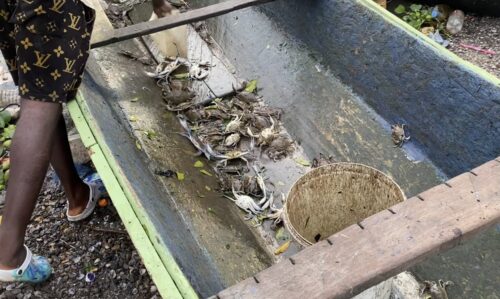 As the rain started to ease up a bit, I peered out and Mt. Cameroon was visible in the distance. The highest peak in the country as well as Central and Western Africa, the mountain was an active volcano whose last eruption was over ten years ago.
As the rain started to ease up a bit, I peered out and Mt. Cameroon was visible in the distance. The highest peak in the country as well as Central and Western Africa, the mountain was an active volcano whose last eruption was over ten years ago.
Standing at over 4,000 meters, it was rare to see it in the daytime, and is not easy to casually hike due to the steep and rocky nature of the volcano.
Another Engine Break
At long last, the engine wound down for a longer period and we looked around to see a man shouting with one of our guides. The weather was still too dreary and wet for the feeding and viewing so we were to go to our second destination first. Luckily, it was less than ten minutes away from the dock at Marienberg, a small community just down the river.

Everyone shook off their vests as we put-putted to a stop at some uneven rock steps, and the first thing I saw upon reaching the dirt clearing was a large cemetery with crosses.
Just beyond it, up a slight incline, stood the first Catholic church in Cameroon. When Germany became the primary colonial power in 1884, their Catholic church soon followed.
On October 25, 1890, eight missionaries from the Pallottine society of the Roman Catholic Church of Germany landed and established their first base church in Marienberg.
When the Germans lost World War I, the French and British empires divided the country into the bilingual country it is today, a move that has led to the current ongoing Anglophone crisis.
A Separatist War in Cameroon
The Northwest and Southwest regions have been calling for independence since 2016, complaining of being marginalized as the minority Anglophone regions, and this crisis has been alternatively also called a conflict, a separatist war, or sometimes, a civil war.
In April 2022, the Catholic church, serving as the root of Catholicism in the country, was the site of a national pilgrimage for leading religious figures in Cameroon as a sign of unity calling for peace to the separatist conflict.
Another issue at the center of the pilgrimage was the ongoing Boko Haram violence in the northern regions of the country.
Preserved in its near original, humble form, the modest yellow and brown building has multiple entrances. We approached the hill towards the side entrances and I peered in to catch the Sunday morning service taking place.
Pews of smaller benches lined both sides of the walkway in, and I saw only children standing in their best church clothes underneath the stained glass windows.
I looped around to the back door, stopping to admire a cross and crucified Jesus overlooking the river, before quietly ducking underneath the inscription commemorating the original Pallottine priests hung over the entrance.
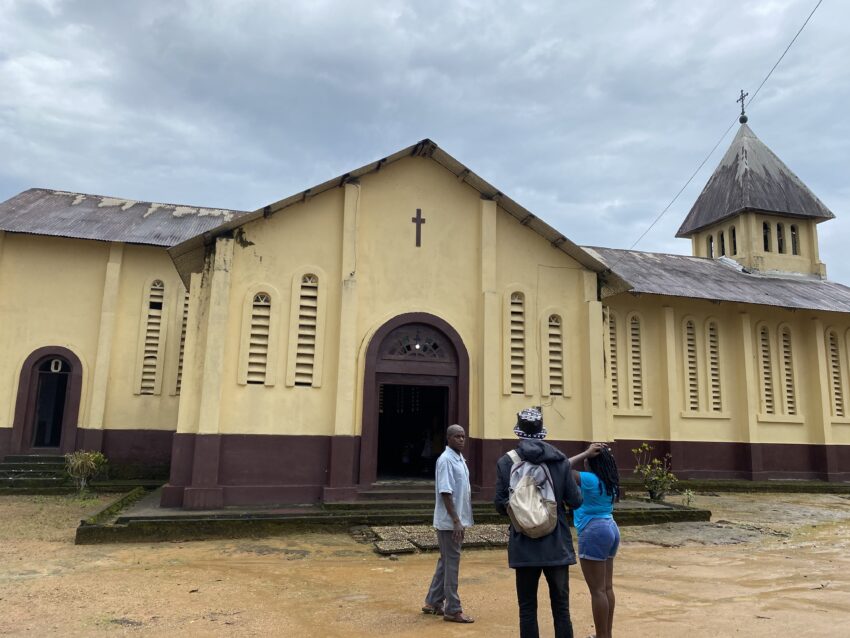
A scattering of adult churchgoers was standing, singing, and harmonizing with the woman leading the drummers in song. Tall arches and long windows let in streaming rays of light, and a metal rooftop was angular with a wooden framework.
A priest swung a smoking burning thurible of incense at the front of the altar, with no less than a dozen figurines of Jesus and Mary, and larger depictions of Christ and the Last Supper hung from the walls.
I moved aside when someone nudged me, and I saw that others were trying to read the tomb engravings of a deceased Pallottine priest next to me buried in the floor.

Feeding the Chimps
We headed back to the boat to make feeding time for the chimpanzees, and the feeders greeted us in their own boat. We followed them, crossing the river, and then stopped about five meters from the opposite shore.
Watching silently, we all took out our cameras as the feeders started calling out and preparing their buckets of peeled oranges, avocados, and bananas.
The black monkeys started appearing, one or two at a time, peering curiously out from the thicket or dropping to the ground and walking right up bravely to the edge.
A mother and her baby clutching the fur on her back grabbed as much of the fruit that had been thrown to the ground before retreating up a tree.
Others fought with one another, shrieking and chasing one another, or playfully splashed water and threw clumps of dirt at the curious onlookers taking pictures from a safe distance away on the boats.
The guide explained that there were 10 adult chimpanzees who lived on this side of the shore. An adult chimpanzee was defined as 13 years or older, and these 10 were between 22 to 24 years old. The opposite shore, where we weren’t permitted to dock due to Covid-19 restrictions, was where the babies were being taken care of and resided before they were moved to the adult side.
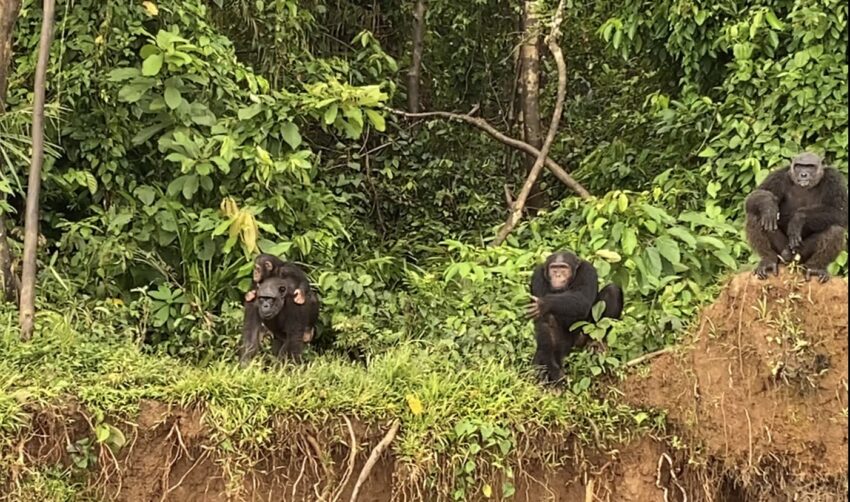
The final stop required us to go further deeper into the reserve, where we traveled five kilometers down a channel that had visibly different greenery. Whereas mangrove branches extended straight into the water and dark green trees extended into the skyline in the initial coastline we passed, within this channel, the tree branches were thinner and the leaves lighter in color.
A thin layer of light green floating moss covered the surface and with the calm reflection in the water, the entire channel seemed brighter and more welcoming.
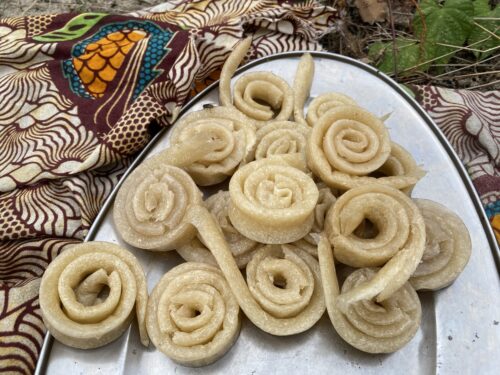
70 Different Birds and Monkeys
We passed a number of water birds, such as storks, sunbirds, and olive pigeons, with up to 70 different types in the reserve, and smaller monkeys clambering on the higher branches, uninterested in our loud motorboat.
The main fishing town of Mouanko flew past on our right, as well as a number of smaller villages whose primary living comes from the catching and selling of carp.

A total of 40 small villages populate the waterfront and a total of approximately 10,000 people, including indigenous groups and tribes.
Elephants, antelope, sharks, rays, manatees, and sea turtles also roam about freely in the reserve, although with the high levels of illegal hunting, they’re harder to see and find these days.
The water level was noticeably higher, due to the downpour in the morning, so our guides in the front and back of the boat had to be vigilant about when to duck around lower hanging branches.
Finally, we arrived at Lake Tissongo, which is directly linked to the river. It quickly became clear why an old grill was squished by my feet on the ride over.
The guides whipped out a bag of coal, a makeshift grill, a stand, and a bag of fresh fish and chicken. While we awaited our protein-heavy lunch, complete with a side of miondo (pounded cassava rolled into long, chewy strips) and fried plantains, some of the others set up an improvised volleyball match in the shallow, warm water.
I jumped in the game as it took off, with bystanders shouting out the score, as we tried not to think about the alligators and any other stray beasts lurking in the reserve just beyond the tall grass of the beach.
- The Interesting Bamileke Region of Cameroon - September 11, 2023
- Mombasa, Kenya: Crocs, Snakes and Empowered Artists - April 9, 2023
- Cameroon’s Douala-Edéa National Park - February 11, 2023


